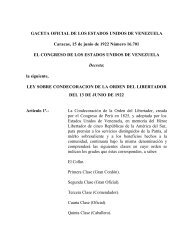1 Observing the normal Zeeman effect in transverse and longitudinal ...
1 Observing the normal Zeeman effect in transverse and longitudinal ...
1 Observing the normal Zeeman effect in transverse and longitudinal ...
Create successful ePaper yourself
Turn your PDF publications into a flip-book with our unique Google optimized e-Paper software.
Figure 4. Fabry-Perot etalon as an <strong>in</strong>terference spectrometer. The ray path is drawn for an angle α > 0 relative to <strong>the</strong><br />
optical axis. The optical path difference between two adjacent emerg<strong>in</strong>g rays is Δ = n(Δ 1 – Δ 2)<br />
In this experiment a Fabry-Perot etalon is used to observe <strong>the</strong>se small changes <strong>in</strong> wavelength. A<br />
Fabry-Perot etalon is a glass plate where <strong>the</strong> two sides are parallel to a very high precision <strong>and</strong> with<br />
both sides alum<strong>in</strong>ized to make <strong>the</strong>m partially reflective. The slightly divergent light enters <strong>the</strong><br />
etalon, which is aligned perpendicularly to <strong>the</strong> optical axis, <strong>and</strong> is reflected back <strong>and</strong> forth several<br />
times, whereby part of it emerges each time (see Fig. 4). Due to <strong>the</strong> alum<strong>in</strong>iz<strong>in</strong>g this emerg<strong>in</strong>g part<br />
is small, i.e., many emerg<strong>in</strong>g rays can <strong>in</strong>terfere. Beh<strong>in</strong>d <strong>the</strong> etalon <strong>the</strong> emerg<strong>in</strong>g rays are focused by<br />
a lens <strong>and</strong> a concentric circular fr<strong>in</strong>ge pattern associated with a particular wavelength λ can be<br />
observed with an ocular (eye-piece).<br />
The rays emerg<strong>in</strong>g at an angle of αk <strong>in</strong>terfere constructively with each o<strong>the</strong>r when <strong>the</strong> path<br />
difference between <strong>the</strong> rays is equal to a whole number of wavelengths (see Fig. 4)<br />
∆ = ∆<br />
1<br />
∆ −<br />
2<br />
d n α k kλ<br />
= − =<br />
2 2<br />
2 s<strong>in</strong><br />
(8)<br />
Δ = optical path difference, d = thickness of <strong>the</strong> etalon, n = refractive <strong>in</strong>dex of <strong>the</strong> glass, k = order<br />
of <strong>in</strong>terference.<br />
A change <strong>in</strong> <strong>the</strong> wavelength of δλ is seen as a change <strong>in</strong> <strong>the</strong> angle, α, of <strong>the</strong> emerg<strong>in</strong>g ray of δα.<br />
Depend<strong>in</strong>g on <strong>the</strong> focal length of <strong>the</strong> lens, <strong>the</strong> angle, α, corresponds to a radius, r, <strong>and</strong> <strong>the</strong> change <strong>in</strong><br />
<strong>the</strong> angle δα to a change <strong>in</strong> <strong>the</strong> radius δr. If a spectral l<strong>in</strong>e conta<strong>in</strong>s several components with a<br />
difference <strong>in</strong> wavelength of δλ, each circular <strong>in</strong>terference fr<strong>in</strong>ge is split <strong>in</strong>to as many components<br />
with <strong>the</strong> radial distance δr. So a spectral l<strong>in</strong>e doublet is recognized by a doublet structure <strong>and</strong> a<br />
spectral l<strong>in</strong>e triplet by a triplet structure <strong>in</strong> <strong>the</strong> circular fr<strong>in</strong>ge pattern.<br />
Part 1. Qualitative observation of <strong>the</strong> <strong>normal</strong> <strong>Zeeman</strong> <strong>effect</strong><br />
Setup<br />
The complete experimental setup <strong>in</strong> <strong>transverse</strong> configuration is illustrated <strong>in</strong> Fig. 5.<br />
4

















